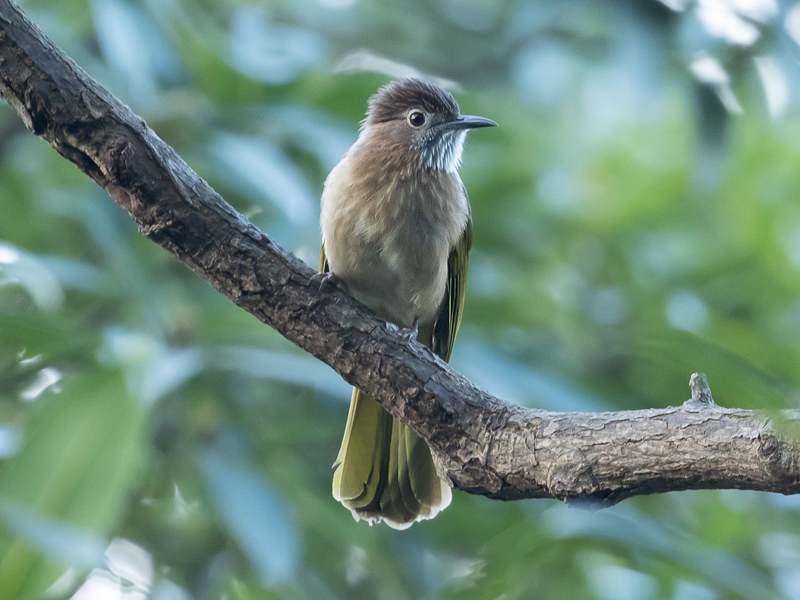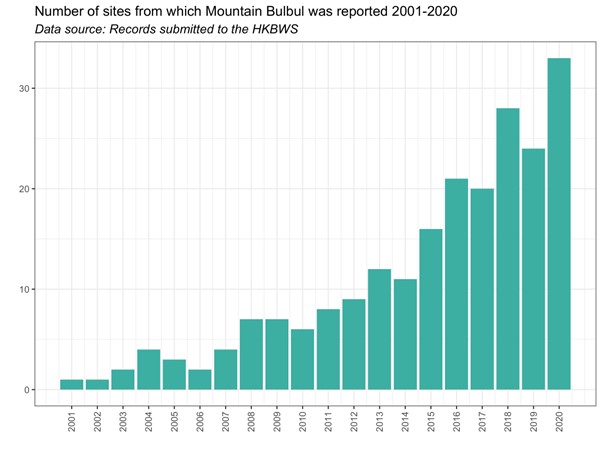Mountain Bulbul Ixos mcclellandii 綠翅短腳鵯
Category I. Uncommon and localised but increasing and spreading resident in forest; a recent colonist, first recorded in 2001.
IDENTIFICATION

May 2021, Michelle and Peter Wong.
21 – 24cm. A large bulbul with a ragged, partially erectile crest. Crown is dark brown contrasting with buff sides of the head and elongated feathers of greyish-white throat which are often puffed out. Mantle, back and rump are greyish-brown, whilst wings and tail are lime-green.

Dec. 2019, Daphne Wong.
The underparts are largely warm buff with yellowish undertail coverts. The iris is chestnut, the bill is dark grey and the legs and feet are greyish-pink.
VOCALISATIONS
Vocal and often noisy. Perhaps the commonest call is a double note, sharply downslurred ‘syip-yip’.
Excited parties give a range of calls.
The flight call is a single note sharply downslurred ‘syip’.
Less often heard is a softer ‘choo’ or ‘choop’.
DISTRIBUTION & HABITAT PREFERENCE
Despite its English name, and its being largely a montane or submontane species in the Himalayas and in southeast Asia, Mountain Bulbul is not restricted to higher altitudes in mainland China where it occurs down to 200m elevation (Liu and Chen 2021) or even lower in the cool months. It is regularly seen at low altitudes in HK, even down to sea level. It is, however, restricted to forest, and, at least at present, numbers appear to be highest in more mature and extensive forest sites such as Tai Po Kau and Tai Lam, Ma On Shan and the Sai Kung Country Parks.
Not recorded from the first breeding atlas survey, Mountain Bulbul was noted in just one square (0.1%) in the 2001-05 winter atlas survey, but by the time of the 2016-19 surveys it was reported from 1.8% of squares in the breeding season survey and 2.7% of squares in winter, suggesting that it is somewhat more widespread, or is at least more conspicuous, outside the breeding season.
OCCURRENCE
Mountain Bulbul was first recorded in HK on 7 December 2001 when one was seen at Tai Po Kau (Kwan and Wong 2007); a group of up to four were subsequently seen there from 5 January to 16 February 2002. It was not recorded again until 7 January 2003, also at Tai Po Kau, but there were further records that year at Tai Po Kau in March, April and December and one, the first at another site, was seen at Ng Tung Chai on 12 March. In 2004, Mountain Bulbul was recorded at four sites, including Beacon Hill, the first report away from the central New Territories, and breeding took place at Tai Po Kau where two adults and two juveniles were seen on 4 August.
In subsequent years Mountain Bulbul has continued to spread; it was first observed in the northeast New Territories in 2008 and the southeast New Territories in 2009. The number of sites from which Mountain Bulbul was reported each year is shown in Figure 1, these totals are approximate in later years as what constitutes a ‘site’ for a forest species is somewhat subjective, especially in the well-forested central and eastern New Territories.
Mountain Bulbul mostly appears to be dispersive outside the breeding season, rather than migratory or irruptive, and there is no evidence to suggest that birds from further north regularly winter in HK. However, some post-breeding and winter movements do take place, as is attested by a handful of winter records from city parks in Kowloon and HK Island, and single reports from Cheung Chau, Lamma and Po Toi, all since 2019 (eBird 2023). Such records span the period from 12 September 2019 at Ho Man Tin to 22 April 2022 at North Point, HK Island, with none in late spring or summer; the span of dates suggests that such records refer to wintering birds that have made at least short migratory movements. Such short-distance migration or dispersal is assumed to be the source of colonising birds in HK.
This colonisation may be an element of a wider increase in range in Guangdong Province: Mountain Bulbul was not recorded from Dinghu Shan, a site covered extensively, by Vaughan and Jones (1913), but it has been seen there since at least 1985, whilst there are also several records from forest parks near Guangzhou this century, and, closest to HK, from Wutongshan in 2009 (eBird 2023).
BREEDING
Breeding ecology of Mountain Bulbul has not been studied in any detail in HK. Incidental observations from Tai Po Kau include individuals carrying nest material on 21 March and 5 April and juveniles seen on 15 April, 18 June (recently fledged) and being fed as late as 20 September, suggesting that it may be double or triple-brooded.
BEHAVIOUR, FORAGING & DIET
Mountain Bulbul is found singly or in pairs or small parties foraging or moving through the forest canopy, where, unlike Chestnut Bulbul, it often perches in the open, sometimes selecting dead snags or trees. It appears to occur at lower densities than HK’s other forest bulbuls, even at sites such as Tai Po Kau where it has been established for longest; the highest single site count is of 20 at Mui Tsz Lam, Ma On Shan on 20 October 2012, whilst the largest flock on record is of 15 seen at Tin Liu Ha, Lam Tsuen Valley on 29 August 2020. However, Mountain Bulbul often joins mixed flocks, both with other bulbuls and with other species.
Whilst its diet has not been studied in HK, Mountain Bulbul is most likely an insectivore-frugivore like other bulbuls here. Incidental reports refer to its eating fruit of the tree Ilex rotunda and the shrub Psychotria asiatica, and feeding at the flowers of Rhodoleia championii, though in the latter case it is not clear if they were feeding on insects, pollen, nectar or indeed on the flowers themselves.
RANGE & SYSTEMATICS
The range extends from northwest India in the west, east through the southern Himalayas, and south throughout continental southeast Asia (Fishpool and Tobias 2020). It occurs throughout central and southern China north and east to central Sichuan, southern Shaanxi, southern Henan, central Anhui and northern Zhejiang (Liu and Chen 2021).
There are ten subspecies, three of which occur in China: I. m. holtii is widespread in central, south and southeast China including HK.
CONSERVATION STATUS
IUCN: Least Concern. Population trend stable.
Figure 1.

eBird. 2023. eBird: An online database of bird distribution and abundance [web application]. eBird, Cornell Lab of Ornithology, Ithaca, New York. Available: http://www.ebird.org. (Accessed: 28 December 2023).
Fishpool, L. and J. A. Tobias (2020). Mountain Bulbul (Ixos mcclellandii), version 1.0. In Birds of the World (J. del Hoyo, A. Elliott, J. Sargatal, D. A. Christie, and E. de Juana, Editors). Cornell Lab of Ornithology, Ithaca, NY, USA. https://doi.org/10.2173/bow.moubul2.01
Kwan, P. K. and C. O. Wong (2007). Mountain Bulbul Hypsipetes mcclellandii at Tai Po Kau: the first Hong Kong record. Hong Kong Bird Report 2001-02: 186-187.
Liu, Y. and S. H. Chen (eds) (2021). The CNG Field Guide to the Birds of China (in Chinese). Hunan Science and Technology Publication House, Changsha.
Vaughan, R. E. and K. H. Jones (1913). The birds of Hong Kong, Macao and the West River or Si Kiang in South-East China, with special reference to their nidification and seasonal movements. Ibis 1913: 17-76, 163-201, 351-384.

